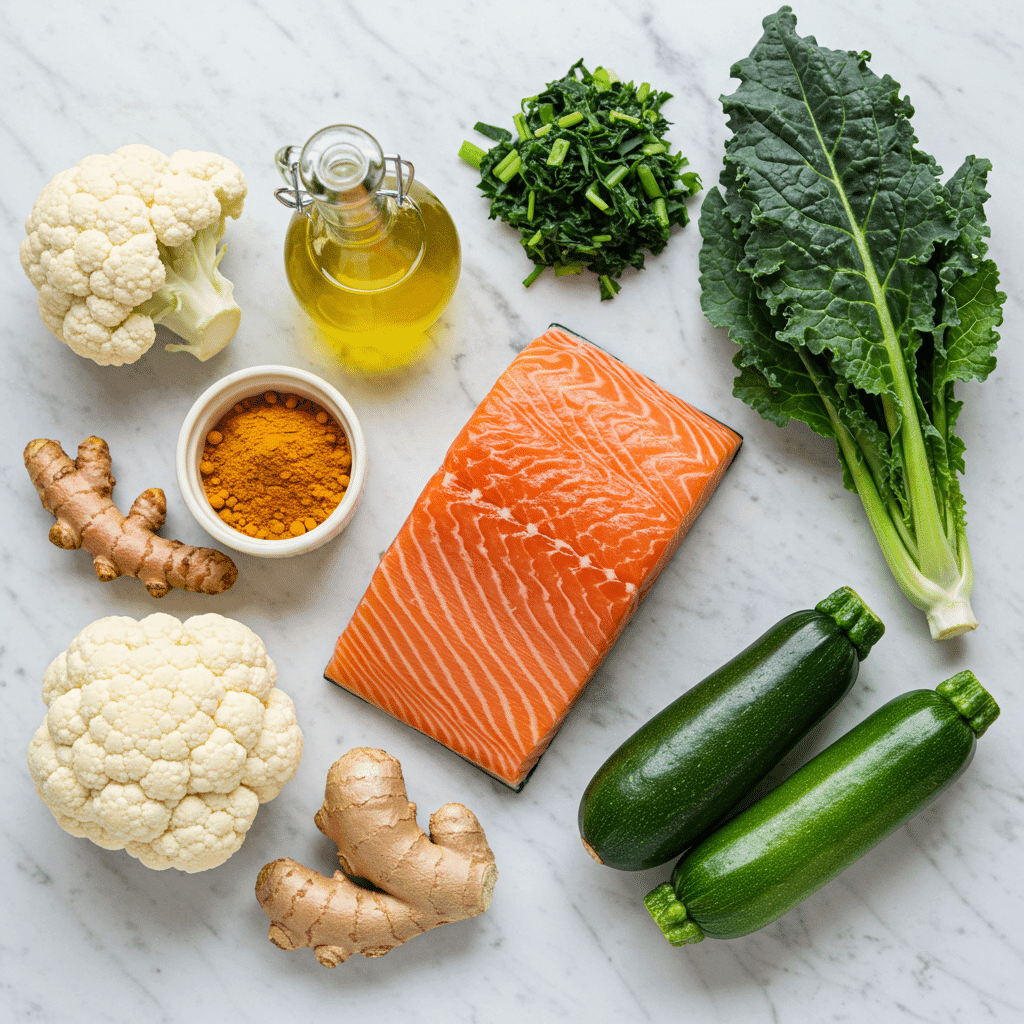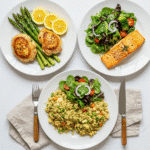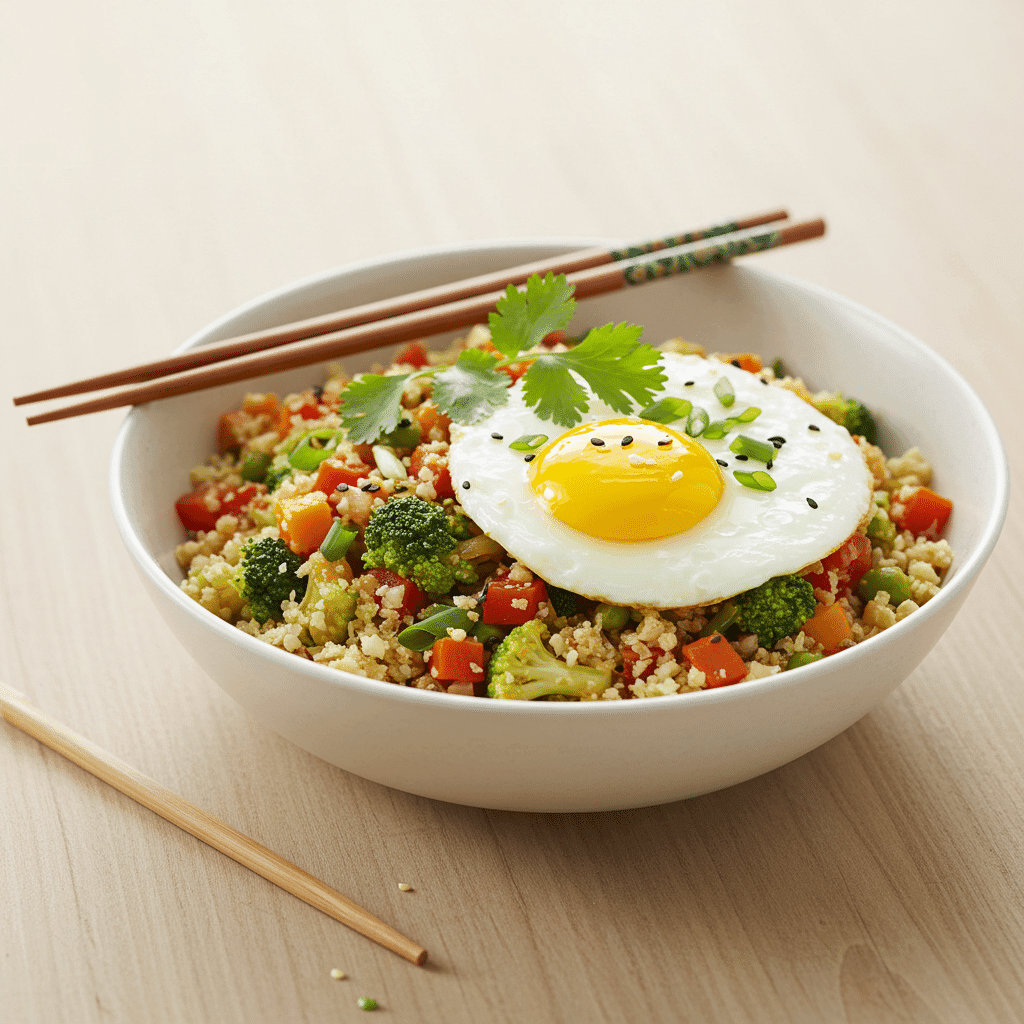A few years back, if someone had told me I’d be cooking low-carb anti-inflammatory meals and loving every bite, I would’ve laughed—with one hand in a takeout bag. I didn’t grow up cooking much, and honestly, I used to think “anti-inflammatory” was just another trendy buzzword. But everything changed when I started noticing how food affected how I felt—bloated, sluggish, and out of balance more often than not.
And here’s the wild part: low-carb anti-inflammatory meals turned out to be way more satisfying than I ever imagined. I wasn’t sacrificing flavor or fun—I was just learning new ways to combine simple, wholesome ingredients. Now, I share those same kinds of recipes here, hoping to help others who feel like I once did: overwhelmed, tired, and not sure where to start.
Table of Contents
What “Low-Carb Anti-Inflammatory” Really Means
When we talk about low-carb anti-inflammatory meals, we’re talking about real food that supports your body—not diet food, not bland food, and definitely not food that leaves you hungry an hour later. These meals focus on whole ingredients like wild salmon, leafy greens, healthy fats (hello, avocado), and naturally low-carb vegetables like zucchini and cauliflower.
Pairing anti-inflammatory principles with a low-carb foundation can support steady energy, reduce bloat, and help calm inflammation from the inside out. For me, it’s made a huge difference in how I feel day-to-day.
If you’re wondering how to begin, start with recipes like my go-to zucchini lasagna bake or a bold chicken cauliflower stir-fry. Both are great examples of low-carb anti-inflammatory meals that hit the spot without spiking your blood sugar or leaving you feeling weighed down.
Even if you’re just testing the waters, adding a few low-carb anti-inflammatory meals to your week can make a noticeable difference—no strict dieting required.

Best Ingredients for Low-Carb Anti-Inflammatory Meals
What Is the #1 Most Anti-Inflammatory Food?
the #1 most anti-inflammatory food, fatty fish like wild-caught salmon come out on top. That’s not just hype—it’s backed by research. Salmon is packed with omega-3 fatty acids, which help dial down inflammation and support your brain, heart, and joints.
In my kitchen, salmon is a weekly regular. It’s fast, flavorful, and incredibly versatile. One of my favorite ways to cook it is a one-pan baked turmeric salmon with garlic and lemon. Just coat the fillet with olive oil, a pinch of turmeric, fresh cracked pepper, and lemon slices. Bake it at 375°F for about 12–15 minutes and serve it over sautéed kale or riced cauliflower for a dinner that tastes rich but fits beautifully into a lineup of low-carb anti-inflammatory meals.
Another trick? Toss leftovers into lettuce wraps or flake it over a salad the next day. The goal is simple: eat more foods that actually fight inflammation—not fuel it.
You can also pair this kind of dish with something like my low-carb roasted veggie bowl or the anti-inflammatory garlic greens skillet—they round out the plate without weighing you down.
What Is the Least Inflammatory Carb?
Now here’s the fun part—carbs aren’t the enemy. You just need to know which ones work with your body, not against it. The least inflammatory carbs are the ones that are unprocessed, fiber-rich, and naturally low on the glycemic index. Think leafy greens, cruciferous veggies like broccoli, and root veggies in moderation (like turnips or rutabagas).
But if I had to pick one all-star? Cauliflower. It’s not just low in carbs—it’s also anti-inflammatory, loaded with vitamin C, and ridiculously flexible. I use it for cauliflower rice, mash, and even pizza crust on busy nights.
One of my personal go-tos is a skillet cauliflower “fried rice” with coconut aminos, ginger, garlic, and whatever leftover veggies I have on hand. Add a fried egg on top and call it dinner. It’s cozy, deeply flavorful, and checks every box for low-carb anti-inflammatory meals.
For those who still miss classic comfort foods, I promise you—cauliflower mash with a pat of grass-fed butter will give mashed potatoes a run for their money.
Print
Low-Carb Anti-Meals Amazing & Satisfying Ideas Satisfy
- Total Time: 25 minutes
- Yield: 2 servings 1x
Description
Easy and flavorful low-carb anti-inflammatory meals that support joint, gut, and overall wellness using real food.
Ingredients
2 salmon fillets
1 tbsp olive oil
1 tsp turmeric
2 cloves garlic, minced
1 lemon, sliced
2 zucchini, spiralized
1 cup cauliflower rice
Fresh herbs (parsley, cilantro)
Instructions
1. Preheat oven to 375°F.
2. Rub salmon with olive oil, turmeric, garlic, and top with lemon slices.
3. Bake salmon for 12–15 minutes.
4. Sauté zucchini noodles in olive oil until just tender.
5. Serve salmon over cauliflower rice or zoodles.
6. Top with fresh herbs and enjoy!
Notes
Swap salmon for chicken or shrimp.
Use frozen cauliflower rice for convenience.
Add a pinch of black pepper to boost turmeric absorption.
- Prep Time: 10 minutes
- Cook Time: 15 minutes
- Category: Dinner
- Method: Bake + Sauté
- Cuisine: Healthy
Nutrition
- Serving Size: 1 plate
- Calories: 420
- Sugar: 3g
- Sodium: 180mg
- Fat: 25g
- Saturated Fat: 4g
- Unsaturated Fat: 18g
- Trans Fat: 0g
- Carbohydrates: 11g
- Fiber: 4g
- Protein: 32g
- Cholesterol: 75mg
Keywords: low-carb anti-inflammatory meals, easy dinners, real food
Simple Anti-Inflammatory Dinners That Don’t Taste Like “Health Food”
What Is a Good Anti-Inflammatory Meal for Dinner?
Dinner is where a lot of us fall off track—not because we don’t care, but because we’re tired, hungry, and the couch is calling. That’s why I started building a small rotation of low-carb anti-inflammatory meals that come together quickly and feel like comfort food.
One of my current favorites? A skillet lemon-garlic chicken with zucchini noodles. You just sauté chicken thighs (or breast, but thighs = more flavor) in olive oil, add a splash of bone broth, lemon juice, and plenty of garlic. Toss in spiralized zucchini at the end and finish with chopped parsley. It’s light but deeply satisfying and 100% fits into the kind of low-carb anti-inflammatory meals I make on busy weeknights.
Another weeknight lifesaver in my house is a sheet pan dinner with shrimp, bell peppers, and red onion, tossed in olive oil, turmeric, cumin, and black pepper. Bake at 400°F for about 15 minutes, and you’ve got a meal that’s naturally anti-inflammatory, low in carbs, and full of flavor. It’s the kind of dish that proves low-carb anti-inflammatory meals don’t have to be bland or boring—they can be colorful, juicy, and crave-worthy.
You can serve these with sides like my roasted garlic cabbage steaks or top with a spoonful of avocado herb sauce if you’re feeling extra.
The point is, a good anti-inflammatory meal for dinner doesn’t have to be fancy or take forever. If you’ve got some lean protein, colorful veggies, and healthy fat, you’re already on the right track.
Are Potatoes OK on an Anti-Inflammatory Diet?
Ah, potatoes. Beloved comfort food—but do they belong in low-carb anti-inflammatory meals? The short answer is: sometimes. White potatoes are higher in carbs and can spike blood sugar, but they aren’t inherently inflammatory for everyone. It really depends on your goals and how your body reacts to starchy carbs.
That said, on most low-carb days, I skip them and go with better options like roasted turnips, mashed cauliflower, or baked Japanese sweet potatoes (lower GI than regular ones and rich in antioxidants). They give you that cozy, starchy feeling without tipping your carb count through the roof.
If I do use potatoes, it’s usually a small serving, roasted with olive oil, garlic, and rosemary—which slows the blood sugar spike and bumps up flavor. But when I’m sticking to low-carb anti-inflammatory meals during the week, I stick to swaps that deliver on texture without messing with my energy levels.
Practical Tips for a Low-Carb Anti-Inflammatory Lifestyle
Smart Substitutions That Work
One of the biggest myths about low-carb anti-inflammatory meals is that they’re complicated. But honestly? Most of the time, it’s just about making one or two smart swaps. No gimmicks. No weird powders. Just regular ingredients used in creative ways.
For example, instead of using white rice, I go with cauliflower rice. You can buy it frozen or pulse it fresh in a food processor. Either way, it absorbs flavor beautifully and keeps the carb count low. Pasta? Zucchini noodles, spaghetti squash, or shirataki noodles do the trick depending on what kind of texture you’re after.
If a recipe calls for breadcrumbs, I reach for ground flaxseed or almond flour. Both keep that crispy texture without the blood sugar spike. I even keep a container of homemade almond cracker crumbs in the pantry for quick coating or topping.
Swapping can also happen in flavor—herbs and spices are a game-changer in low-carb anti-inflammatory meals. Think garlic, cumin, turmeric, ginger, cinnamon, and fresh herbs. They help fight inflammation and boost flavor. So meals still feel exciting, even when you’re avoiding refined carbs.

Keeping It Real: Pantry and Prep Tips
I won’t pretend I meal prep like a pro every Sunday. Some weeks I don’t prep at all. But I’ve learned a few small things that make low-carb anti-inflammatory meals more doable during the week.
First, I keep a basic anti-inflammatory pantry stocked. That means olive oil, avocado oil, canned wild salmon or sardines, coconut milk, raw nuts, chia seeds, and low-carb veggies like cabbage, onions, and frozen cauliflower. With just those, I can pull together a skillet or soup in under 20 minutes.
I also rely on simple batch-cooking. Roasting a big tray of veggies or chicken thighs means you’ve got flexible building blocks for multiple meals. Toss roasted broccoli into a salad. Use the leftover chicken for lettuce wraps.
And here’s the truth: sometimes I use shortcuts. Pre-spiralized veggies, pre-washed greens, or even store-bought pesto (just check ingredients). These little choices make it more realistic to stay consistent with low-carb anti-inflammatory meals, even when life is anything but chill.
Consistency doesn’t mean cooking from scratch every night. It means finding rhythms and ingredients that support you—and that you actually want to eat.
FAQ: Low-Carb Anti-Inflammatory Meals
What is a good anti-inflammatory meal for dinner?
A good anti-inflammatory dinner includes lean protein (like salmon or chicken), non-starchy vegetables (such as zucchini or broccoli), and healthy fats (like olive oil or avocado). Meals like garlic lemon chicken with sautéed kale or shrimp stir-fry with turmeric and peppers are easy, delicious options that support an anti-inflammatory approach.
What is the #1 most anti-inflammatory food?
Wild-caught salmon ranks as one of the most powerful anti-inflammatory foods due to its rich content of omega-3 fatty acids. Regularly including salmon in your low-carb anti-inflammatory meals can help calm inflammation and support joint, brain, and heart health.
What is the least inflammatory carb?
The least inflammatory carbs are whole-food, fiber-rich, and low on the glycemic index. Leafy greens, cauliflower, turnips, and cruciferous vegetables are all great options. Cauliflower in particular is a star in low-carb anti-inflammatory meals thanks to its versatility and gentle effect on blood sugar.
Are potatoes OK on an anti-inflammatory diet?
Potatoes aren’t inherently inflammatory, but their high carb content may not fit into most low-carb anti-inflammatory meals. If you do include them, opt for small portions and pair them with healthy fats and fiber. Or swap them for alternatives like mashed cauliflower or roasted turnips to keep meals lighter and more blood-sugar friendly.
Final Thoughts: Low-Carb Can Still Mean Comfort
Low-carb anti-inflammatory meals don’t have to be boring, complicated, or restrictive. They can be vibrant, bold, and satisfying enough to crave—even on a Tuesday night when you’re running on empty
If you’re looking for more real-food ideas that actually work in real life, I share even more recipes over on Pinterest—quick weeknight meals, cozy bowls, and plenty of low-carb anti-inflammatory favorites.